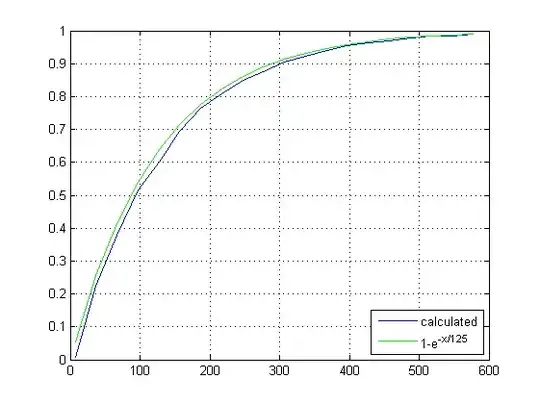If I toss a fair coin $n$ times, calculate the probability that no pattern HHTHTHH occurs.
3 Answers
I ended doing something very similar to Moron.
Define a Markov chain with states i=0..7 as follows. Given a full sequence of n coins, if the pattern has not yet appeared, find the maximum length of the last tosses (sequence suffix) that coincide with the begginning of the expected pattern, so that
i = length of matching suffix , if pattern has not appeared
i = 7 otherwise
For example: HTTHTTTTHT : i=0 , HTTTTHHT i=3
It's easy to write down the transition probabilities. (i=7 would be a absorbent state), and the probability of being in state 7 in step n.
So your anwser would be $ P(n) = 1- p_7[n]$ where $p[n] = M^n p[0]$ where $M$ is the 8x8 transition matrix and $p[0] = (1,0,0,0,0,0,0,0)$ is the initial state. I doubt you'll get a simpler closed form answer.
One could get a very coarse approximate solution by assumming that the patterns starting at each position are independent (obviously a false assumpion), and get $ P(n) \approx (1-2^{-7})^{n-6}$ ($n \ge 7$)
UPDATE: some Octave/Matlab code to test the approximation (it seems to work better than I'd expected)
N=200;
% approximation
pa = (1-1/128).^((1:N)-6);
pa(pa>1)=1;
% transition matrix:
M = [ 1,1,0,0,0,0,0,0 ;
1,0,1,0,0,0,0,0 ;
0,0,1,1,0,0,0,0 ;
1,0,0,0,1,0,0,0 ;
0,0,1,0,0,1,0,0 ;
1,0,0,0,0,0,1,0 ;
1,0,0,0,0,0,0,1 ;
0,0,0,0,0,0,0,2 ]/2;
p=[1,0,0,0,0,0,0,0];
p7=zeros(1,N);
p7(1)=1;
for n = 1:N
p = p * M;
p7(n) = 1 - p(8);
endfor
plot(7:N,p7(7:N),7:N,pa(7:N));
>>> pa(5:9)
ans =
1.00000 1.00000 0.99219 0.98444 0.97675
>>> p7(5:9)
ans =
1.00000 1.00000 0.99219 0.98438 0.97656
>>> pa(N-5:N)
ans =
0.22710 0.22533 0.22357 0.22182 0.22009 0.21837
>>> p7(N-5:N)
ans =
0.22717 0.22540 0.22364 0.22189 0.22016 0.21844
- 63,430
Construct a deterministic finite automaton which detects the regular expression $.*(HHTHTHH).*$ such that the sole accepting state $A$ always transitions to a state $B$, which always transitions to itself. The starting state is $S$.
This is basically a directed graph and we can find the transition matrix $P$, each row of which gives the probabilities of getting from one state (i.e. vertex) corresponding to that row, to the next states (one vertex corresponding to each column).
You basically need the entries corresponding to starting state $S$ and ending state $A$, from each of $P, P^2, P^3, \dots , P^n$ and add them up to get the probability that the pattern $HHTHTHH$ occurs (or more simply the $(S,B)$ entry of $P^{n+1}$ will do). Subtract that from $1$ and you are done.
The $(S,A)$ entry of $P^k$ gives the probability that we find the pattern exactly at the end of $k$ tosses, and no tosses before that.
- 82,206
-
not completely get your solution. Is it possible for you to use this method to get a recurrence formula for the probability in question? – Qiang Li Jan 19 '11 at 17:13
-
@Qiang: It gives you multiple recurrences (one for each state). You can diagonalize the matrix (if that possible) to compute the powers easily. – Aryabhata Jan 19 '11 at 18:43
I don't know about exact solution, but numeric approximation is $P(n)=1-e^{-\frac{n}{125}}$.

Matlab\Octave Code
function test_script_1()
x=7:30:600;
y=tsh([],5000,7:30:600);
er=@(p)sum(((p(1)+p(2)*exp(p(3)*x/500))-y).^2);
an=fminsearch(er,[0,0,0]);
anr=round(an);
disp(anr);
plot(x,y,x,anr(1)+anr(2)*exp(anr(3)*x));
legend('calculated','1-e^{-x/125}',4)
end
function result=tsh(a,b,n)
% HHTHTHH (H -> 1 , T -> 0)
if isempty(a)
a=logical([1 1 0 1 0 1 1]);
end
if isempty(b)
b=1000;
end
if isempty(n)
n=100;
end
if any(size(n)>1)
result=zeros(size(n));
for pa=1:length(n)
result(pa)=test_script_1(a,b,n(pa));
end
return
end
la=length(a);
t=false(1,b);
for i=1:b
v=raspr(0,1,n);
for j=1:n
if all(a==v(j:j+la-1))
t(i)=true;
break
end
end
end
result=nnz(t)/b;
end
function resu=raspr(a1,b1,s)
resu=round((b1-a1+1)*rand(1,s)+a1-0.5);
end
Somebody know why is that?
- 93
-
Because you can treat the problem as a rare event problem, i.e. the probability of encountering the sequence HHTHTHH is small. Therefore the probability distribution for the waiting time to encountering the sequence will be approximately exponential. So you only need to compute find the expectation value of the waiting time to have a nice exponential approximation. I guess that can be found by a simple recursion relation. – Raskolnikov Jan 20 '11 at 13:11
-
-
Yes, the law is expected to be exponential. In fact, if you see my approximation, it's practically the same (127.5 instead of 125, and a -6 shift that is unimportant for large n. – leonbloy Jan 20 '11 at 21:45
-
2@Qiang Li - you right, i have read the question wrong. But it still correct for inverse problem – Alexander Jan 20 '11 at 22:17
q(i)=probability that, after tossing coin number i, the sequence is just completed (in positions i-7,i) (no necesarily for the first time)This is 0 for i<7, 2^=128 otherwise. The prob. of the sequence NOT having appeared after N tosses, is then prod(1-q(i))... if the events were independent. – leonbloy Jan 20 '11 at 00:23